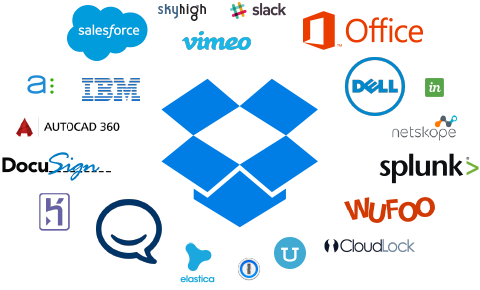As The Cost of Cloud Storage Approaches Zero, How Will Dropbox Compete?
In “Dropbox Against The World”, J.J. McCorvey of Fast Company profiles Dropbox and its founder and CEO Drew Houston:
The stakes are clear: whomever controls your stuff may control the digital future. Over the last few years, storing and sharing data in the cloud has become an almost ubiquitous habit. Conventional wisdom had been that cloud-based storage was a commodity business, a digital file cabinet. But a better metaphor for the potential of cloud-based storage might be a portable office. “Your whole computing environment ought to follow you around,” explains Houston. “Your financial records, your health information, your music playlist … anything that’s ‘mine.’ It’s a pretty long list.” Better yet, you should eventually be able to interact seamlessly with everything in that portable office: work on documents with colleagues, send email, chronicle inventory. About storage, he says, “that’s kind of the easy part. The more interesting part is, What can you do with it?”
Dropbox, from its inception, has held a foothold in consumer cloud storage, being an early hit since launching at Y Combinator, and having one of the most storied referral programs in software history which got them 4 million users in 15 months. It was impossible to deny their hot streak. Today, Dropbox has 300 million users with 4 million companies using the service, and is valued at $10 billion, currently sharing the “decacorn1” mantle only with Airbnb, Flipkart, Pinterest, Palantir, Snapchat, SpaceX, Uber, and Xiaomi.
Their biggest challenge, however, is justifying that massive valuation and convincing users to pay for the product, currently at $10 per month for one terabyte, or $15 per month for unlimited storage for business users, which is a very competitive price with that of Google, Box, Microsoft, and now Amazon. What Dropbox needs is to differentiate itself from their competitors, and establish a niche that provides enough value for users to want to pay a premium for their service. In short, Dropbox, first has to convince users that their data is valuable enough to pay for, and then convince them that Dropbox is the best option for their needs.
Dropbox is attacking this in two fronts: in the consumer space and business space. For the former, they acquired the minimalistic inbox zero app Mailbox and released the beta version for the Mac this year to wide acclaim. They also bought photo storage startups Loom and Snapjoy, eventually launching an all-in-one photo app of their own in Carousel. For the latter, they acquired a number of enterprise software companies such as Hackpad, Pixelapse, MobileSpan, and most recently, CloudOn, to support development of their newly launched Dropbox for Business, which also partnered with Microsoft to provide Dropbox integration for Office.
At the outset it may seem that their strategy is rather confused in trying to attack two markets, not to mention the big challenges they face in each:
- It’s tough to get regular consumers to pay for software—let alone for storage which is approaching free and in a very crowded market.
- Regular consumers for the most part don’t have a terabyte of data (yet) to justify paying $10 a month.
- While they have attractive consumer offerings in Mailbox and Carousel, other companies also have competitive offerings of their own that when put together, Dropbox just doesn’t match—at least right now. Google has Google Apps, integrated with the Google universe in Mail, Calendar, Hangouts, Inbox, and others. Microsoft has the entire Office suite, OneDrive, and recently bought professional email app Acompli (re-branded as Outlook for iOS and Android) and Sunrise, the design-focused calendar app.
- As for the business space, Box and Microsoft are already heavily embedded in the enterprise, as they have the established platforms and architecture necessary to support that market.
If Dropbox can’t compete on price alone, and their competitors have matching offerings that have better and more function than what they have, how then, can Dropbox compete?
Perhaps, Dropbox’s biggest advantage may just be using what they’ve already had all along and what put them on the top of consumer cloud—a laser-like focus on user experience combined with the most robust and widespread integration than any cloud company today. In both of these instances, Dropbox is far and away the leader, and its simplicity is what got them there. They now have a presence in 300,000 apps and rising, an order of magnitude more than their competitors combined, and since February, has garnered them an action extension in iOS 8, which lets users save photos, notes, and PDFs in iPhones and iPads without having to open the Dropbox app.
Being able to backup to Dropbox from other apps, also called as “Dropbox Sync,” has practically been a mandatory for most apps that run on the cloud, and there’s a chance this will only become more prevalent as more and more individuals and companies use and rely on mobile and the applications inside it to run their lives. What Dropbox hopes, is that this dependence will continue to rise and people will amass loads of valuable data to the point that they’d want to use one service to take care of it all, and that they will choose Dropbox because they provide the best cross-platform experience, with simplicity and design tailored to consumers, and it’s already in the apps they use for everyday utility.
If this is the case, Dropbox needs to leverage this control in the consumer and small-to-medium-business markets further, introducing more valuable applications of their own and integrating in the apps that people can’t live without (as with the Office example) to create a worthy central hub of information, and not just merely a place for cloud storage which has become a commodity.
Once they nail the experience required for regular consumers and small teams to have a truly seamless and flexible workflow regardless of what they do, then Dropbox won’t just be a nice-to-have nor just the service where data lives, but the company that sits in the middle of everyone’s favorite applications and services—an absolute must in the age when everything is digital, and the security and accessibility of our personal and professional files is a top priority.
While that offers a huge potential for Dropbox, that is still a question begs to be answered, and a big part of their future depends on this thread. Most certainly though, they have the cash, engineering power, a strong first mover advantage, and perhaps most importantly, a consumer-focused culture—all assets necessary to capture their side of the market. It will be interesting to see what they come up with, and if this current PR run is any indication, it’s likely that they’re prepping for something big this year.
-
Supposedly new slang for tech companies valued $10 billion or more. ↩

